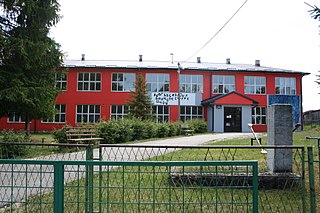
A village is a clustered human settlement or community, larger than a hamlet but smaller than a town, with a population typically ranging from a few hundred to a few thousand. Though villages are often located in rural areas, the term urban village is also applied to certain urban neighborhoods. Villages are normally permanent, with fixed dwellings; however, transient villages can occur. Further, the dwellings of a village are fairly close to one another, not scattered broadly over the landscape, as a dispersed settlement.

Robert Thomas Christgau is an American essayist and music journalist. One of the earliest professional rock critics, he spent 37 years as the chief music critic and senior editor for The Village Voice, during which time he created and oversaw the annual Pazz & Jop poll. He has also covered popular music for Esquire, Creem, Newsday, Playboy, Rolling Stone, Billboard, NPR, Blender, and MSN Music, and was a visiting arts teacher at New York University. Among the most revered and influential of music critics, he has been described by CNN senior writer Jamie Allen as "the E.F. Hutton of the music world – when he talks, people listen."

A model village is a type of mostly self-contained community, built from the late 18th century onwards by landowners and business magnates to house their workers. Although the villages are located close to the workplace, they are generally physically separated from them and often consist of relatively high quality housing, with integrated community amenities and attractive physical environments. "Model" is used in the sense of an ideal to which other developments could aspire.

Ghulam Nabi Azad is an Indian politician of the Indian National Congress and was the Minister of Health and Family Welfare. Recently, he served as the Leader of opposition in Rajya Sabha. He has served as the Parliamentary Affairs Minister of India in the government of former Prime Minister Manmohan Singh until 27 October 2005, when he was appointed as the Chief Minister of Jammu and Kashmir. He also led the party successfully in the 2002 Assembly election in Jammu and Kashmir.
Village Roadshow Pictures is an American co-producer and co-financier of major Hollywood motion pictures, established in 1986. Now a division under Village Roadshow Entertainment Group (VREG), it has produced over 100 films since its establishment in 1986 including, as co-productions with Warner Bros., The Matrix series, the Sherlock Holmes series, the Happy Feet series, the Ocean’s series, The Lego Movie and Joker. The films in the Village Roadshow library have achieved 34 number one U.S. box office openings and received 50 Academy Award nominations, 19 Academy Awards and six Golden Globe Awards.
Gram Panchayat is a basic village governing institute in Indian villages. It is a democratic structure at the grass-roots level in India. It is a political institute, acting as cabinet of the village. The gram-Sabha work as the general body of Gram Panchayat. The members of the Gram panchayat are elected by the Gram Sabha.
The administrative divisions of India are subnational administrative units of India; they compose a nested hierarchy of country subdivisions.

The Kuot language, or Panaras, is a language isolate, the only non-Austronesian language spoken on the island of New Ireland, Papua New Guinea. Lindström estimates that there are 1,500 fluent speakers of Kuot. Perhaps due to the small speaker base, there are no significant dialects present within Kuot. It is spoken in 10 villages, including Panaras village of Sentral Niu Ailan Rural LLG in New Ireland Province.

Stapari is a village located in the Užice municipality of Serbia. In the 2002 census, the village had a population of 974.

Krnjača is a village located in the municipality of Priboj, southwestern Serbia. According to the 2011 census, the village has a population of 149 inhabitants.
Banjevac is a village in Serbia. It is situated in the Krupanj municipality, in the Mačva District of Central Serbia.

Potkrš is a village in the municipality of Prijepolje, Serbia. According to the 2002 census, the village has a population of 124 people.
Zauzou is a Loloish language of Tu'e District 兔峨地区, Lanping County, Yunnan, China. It is most closely related to Nusu.
Kucong, or Lahlu, is a Loloish language of Yunnan and Vietnam. In Vietnam, the speakers' autonym is, and are also known as the La Hủ Na 'Black Lahu'. It is very closely related to Lahu.
Sila is a Loloish language spoken by 2,000 people in Laos and Vietnam. Sila speakers are an officially recognized group in Vietnam, where they are known as the Si La.

Abramtsevo is a rural locality in Spasskoye Rural Settlement of Vologodsky District, Vologda Oblast, Russia. The population was 7 as of 2002. There are 4 streets.

Volochaninovo is a rural locality in Podlesnoye Rural Settlement, Vologodsky District, Vologda Oblast, Russia. The population was 15 as of 2002.

Derevenka is a rural locality in Mayskoye Rural Settlement, Vologodsky District, Vologda Oblast, Russia. The population was 11 as of 2002.
Pandav Lila or Pandav Nritya is a ritual re-enactment of stories from the Hindu epic Mahabharata, through singing, dancing and recitation, that is practised in the Garhwal region of Uttarakhand, India. Pandavas are the five protagonists in the epic and the village amateurs take on their roles and perform the lila outdoors, accompanied by the folk instruments dhol, damau and two long trumpets called bhankore. The performances, which can last anywhere from three days to a month in different villages, draw large crowds and are an important cultural highlight of the year. The ritualistic drama features actors who often spontaneously become "possessed" by the spirits of their characters and begin to dance.








